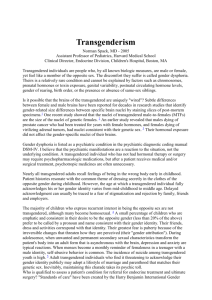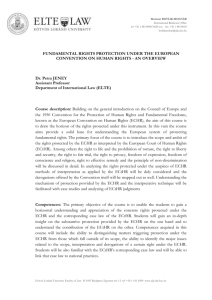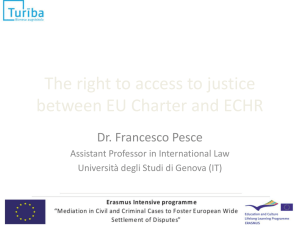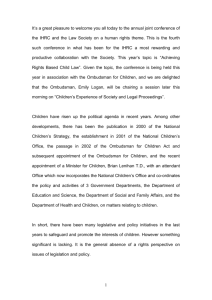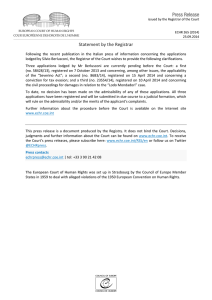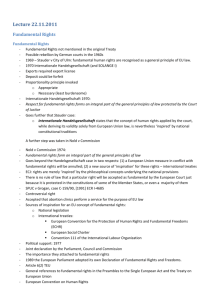now - Irish Human Rights & Equality Commission
advertisement
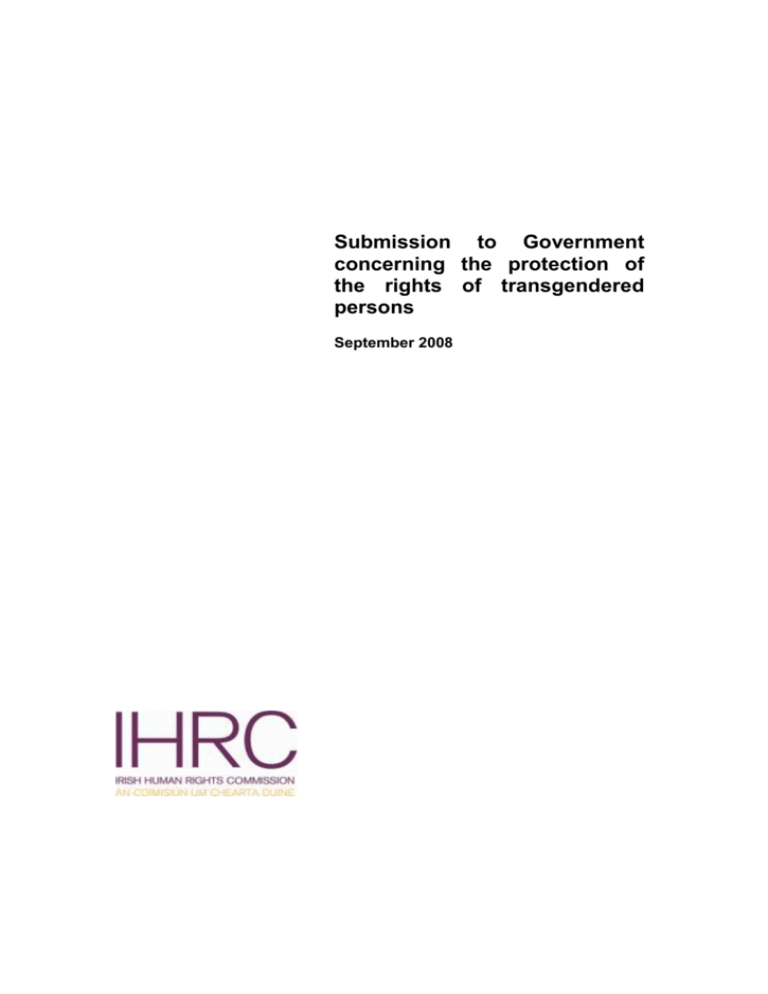
Submission to Government concerning the protection of the rights of transgendered persons September 2008 1) Introduction The Irish Human Rights Commission (“IHRC”) has a statutory remit to endeavour to ensure that the human rights of all persons in the State are fully realised and protected, in law, in policy, and in practice. The IHRC seeks to ensure that Irish law and policy meet the standards of best international practice. Its functions include keeping under review the adequacy and effectiveness of law and practice in the State relating to the protection of human rights, and making such recommendations to the Government as it deems appropriate in relation to the measures which the IHRC considers should be taken to strengthen, protect and uphold human rights in the State. In the present instance, the IHRC is making recommendations to the Government under Section 8(d) of the Human Rights Commission Act 2000 on the measures the Commission considers should be taken to strengthen, protect and uphold human rights in the State and in particular, to ensure the adequate protection of the rights of transgendered persons under Irish law, in line with the State’s obligations under the European Convention on Human Rights (“ECHR”). 2) The Position of Transgendered Persons under Irish Law a. Foy v. An t-Ard Chláraitheoir, Ireland and the Attorney General1 This submission is made following an analysis of the recent jurisprudence of the European Court of Human Rights (“ECtHR”) concerning the protection of the rights of transgendered persons. As such, it is not made on the basis of the High Court Judgment in Foy, which is currently the subject of an appeal to the Supreme Court. However, the Foy case has importantly raised wider issues relating to the protection of the rights of transgendered persons under Irish law. The IHRC was put on notice of the case under Section 6(1) of the European Convention on Human Rights Act 2003 (“ECHRA”). Even prior to 1 Unreported 19 October 2007 (HC). 1 the judgement in that case, in the IHRC’s view, there would appear to be no impediment to the Government considering the issue of the legal recognition of transgendered persons’ rights along similar lines to that considered by the UK Government in the period 1999-2004 as set out in this submission. Foy concerned a transgendered person who was unable to obtain a birth certificate in her new gender. The Plaintiff challenged this refusal on administrative and constitutional law grounds and as being incompatible with the ECHR. Similar arguments had previously been made by the Plaintiff in 2002 before the same High Court Judge. That case was heard before the ECtHR ruled in two cases that the lack of legal recognition for transgendered persons violated the ECHR, and before the ECHRA came into force in the State. In its Judgment of 19 October 2007, the High Court issued a declaration of incompatibility under Section 5 of the ECHR Act 2003, stating that the relevant Irish legislation was incompatible with the ECHR. This decision was underpinned by the two ECtHR cases referred to above, which will be examined below. In particular, the High Court held that the Article 8 ECHR right to respect for private life had been violated. Since the Plaintiff was not in a position to marry, a declaration of incompatibility in respect of the Article 12 ECHR right to marry was not granted. However, the High Court indicated that such a declaration may have been granted under different factual circumstances. The Judgment is currently being appealed to the Supreme Court and consequently, there is a stay on the declaration of incompatibility. b. The Rights Involved: Articles 8 and 12 ECHR Article 8 of the ECHR provides that: 1. Everyone has the right to respect for his private and family life, his home and his correspondence. 2 2. There shall be no interference by a public authority with the exercise of this right except such as is in accordance with the law and is necessary in a democratic society in the interests of national security, public safety or the economic well-being of the country, for the prevention of disorder or crime, for the protection of health or morals, or for the protection of the rights and freedoms of others. Article 12 of the ECHR provides that: Men and women of marriageable age have the right to marry and to found a family, according to the national laws governing the exercise of this right. c. Passports Act 2008 The rights of transgendered persons are gradually being recognised in Irish law. The Passports Act 2008, provides for the right of transgendered persons to apply to have a passport issued in their new gender.2 The IHRC provided observations on the then Passports Bill 2006, pursuant to its mandate under Section 8(b) of the Human Rights Commission Act 2000, in which it strongly welcomed this first statutory recognition of transgender rights in Irish legislation as representing a significant step forward for the protection of the rights of transgendered Irish citizens.3 3) European Caselaw a) European Court of Human Rights As noted above, two ECtHR cases underpinned the High Court decision to issue a declaration that Irish law is incompatible with the ECHR. These were the cases of Goodwin v. The United Kingdom and I. v. The United Kingdom.4 Both cases concerned the rights of transgendered persons to legal Section 11 of the Passports Act 2008. See Section 6 of the IHRC Observations on the Passports Bill 2006, 7 December 2006. 4 Goodwin v. The United Kingdom, Judgment of 11 July 2002, (2002) 35 EHRR 18; I. v. The United Kingdom, Judgment of 11 July 2002, (2002) 2 FLR 518. See also Van Kück v. Germany, Judgment of 12 June 2003, (2003) 37 EHRR 51; Grant v. The United Kingdom, Judgment of 23 May 2006 and L. v. Lithuania, Judgment of 11 September 2007. 2 3 3 recognition and to marry in their new gender. The ECtHR pronounced judgment in both cases on 11 July 2002 and unanimously held that a United Kingdom (“UK”) law preventing transgendered persons from obtaining birth certificates or marrying in their new gender was in breach of Articles 8 and 12 of the ECHR in failing to recognise the applicants’ new gender.5 The Court found that there had been serious interference with the applicants’ right to respect for private life under Article 8 owing to the conflict between the domestic law and an important aspect of personal identity. The Court held: It must also be recognised that serious interference with private life can arise where the state of domestic law conflicts with an important aspect of personal identity […] The stress and alienation arising from a discordance between the position in society assumed by a post-operative transsexual and the status imposed by law which refuses to recognise the change of gender cannot, in the Court's view, be regarded as a minor inconvenience arising from a formality. A conflict between social reality and law arises which places the transsexual in an anomalous position, in which he or she may experience feelings of vulnerability, humiliation and anxiety.6 In addition, the Court held that there were no countervailing factors of public interest to justify the violation of Article 8 occasioned by the failure to recognise the applicants’ new gender: No concrete or substantial hardship or detriment to the public interest has indeed been demonstrated as likely to flow from any change to the status of transsexuals and, as regards other possible consequences, the Court considers that society may reasonably be expected to tolerate a certain inconvenience to enable individuals to live in dignity and worth in accordance with the sexual identity chosen by them at great personal cost.7 The Court held, in relation to the Article 12 right, that an effective bar on any exercise of the right to marry by a transgendered person exceeded the State’s I. v. The United Kingdom, paras 42-84; Goodwin, paras 59-104. See Goodwin, para. 77; see also I. v. The United Kingdom, para. 57. 7 I. v. The United Kingdom, para. 71; Goodwin, para. 91. See also I. v. The United Kingdom, para. 73 and Goodwin, para. 93. The Court rejected arguments in relation to the need to uphold rigidly the integrity of the historic basis of the birth registration system on the basis that exceptions already existed in case of legitimisation or adoptions, and that the Government was planning to change their registration system to one which would allow ongoing amendment to civil status data. See Goodwin, paras 87-88; I. v. The United Kingdom, paras 67-68. 5 6 4 “margin of appreciation”.8 The Court also rejected the use of purely biological factors as the sole basis for gender recognition in relation to the right to marry: There are other important factors – the acceptance of the condition of gender identity disorder by the medical professions and health authorities within Contracting States, the provision of treatment including surgery to assimilate the individual as closely as possible to the gender in which they perceive that they properly belong and the assumption by the transsexual of the social role of the assigned gender.9 The argument that transgendered persons remained able to marry a person of their former opposite sex was also rejected as “artificial”.10 In relation to the “margin of appreciation”, although the Court held that Articles 8 and 12 had been violated, it stated that it was for the national governments to determine the best means of vindicating the rights in question: While it is for the Contracting State to determine inter alia the conditions under which a person claiming legal recognition as a transsexual establishes that gender re-assignment has been properly effected or under which past marriages cease to be valid and the formalities applicable to future marriages (including, for example, the information to be furnished to intended spouses), the Court finds no justification for barring the transsexual from enjoying the right to marry under any circumstances.11 Finally, the Court examined the growing trend in Europe towards legal recognition of transgendered persons, as examined in Section 3(c) below. b) European Court of Justice The European Court of Justice (“ECJ”) endorsed the Goodwin and I. cases in K.B. v National Health Service Pension Agency.12 In that case, the Court Under the case-law of the ECtHR a certain margin of appreciation is allowed to national authorities in assessing whether and to what extent differences in otherwise similar situations justify a different treatment in law. The scope of the margin of appreciation will vary according to the circumstances, the subject-matter and its background. 9 Goodwin, para. 100; I. v. The United Kingdom, para. 80. See also Goodwin, para. 82 and I. v. The United Kingdom, para. 62. 10 I. v. The United Kingdom, para. 81; Goodwin, para. 101. 11 Goodwin, para. 103; I. v. The United Kingdom, para. 83. 12 Case C-117/01 K.B. v National Health Service Pension Agency [2004] ECR I-541, judgment delivered on 7 January 2004, paras 33-36. 8 5 agreed with the ECtHR position that “the fact that it was impossible for a transsexual to marry a person of the sex to which he or she belonged prior to gender reassignment surgery” constituted a breach of the right to marry under Article 12 ECHR.13 It followed that the Article 141 EC provision on equal pay between men and women precluded in principle any legislation preventing such marriage by a transgendered person, given the resulting impact on pension entitlements. c) European-wide trends The wider international acceptance of the rights of transgendered persons to legal recognition was also examined by the ECtHR in the Goodwin and I. cases. In the I. judgment, the Court noted that while there was a lack of evidence of a common European approach to the legal and practical problems posed by that case, there was clear evidence of a continuing international trend in favour of legal recognition of the new sexual identity of transgendered persons. Out of thirty-seven countries surveyed by the Court in 2002, only four did not permit a change to be made to a person’s birth certificate to reflect the re-assigned sex of that person.14 d) United Nations Human Rights Committee Ibid, para. 33. The term “transsexual” refers to a transgendered person. 14 The countries were Albania, Andorra, Ireland and the UK. See joint partly dissenting opinion in Sheffield and Horsham v. The United Kingdom, Judgment of 30 July 1988, (1999) 27 EHRR 163, cited in I. v. The United Kingdom, paras 64-65; Goodwin, paras 55-56. In relation to the right to marry under Article 12 of the ECHR, the Court noted that fewer countries at that time permitted the marriage of post-operative transsexuals in their assigned gender. However, the Court felt that to permit an effective bar on any exercise of the right to marry by a post-operative transsexual would be to give too much scope to the “margin of appreciation”. The Court also noted an international trend towards legal recognition of the rights of transgendered persons outside Europe, e.g. in Singapore, Israel, Australia, New Zealand, Canada, South Africa and almost all states in the United States. Courts in Australia and New Zealand were also moving away at that time from the “biological birth” view of gender and were taking the view that the determination of one’s gender, in the context of a transgendered person wishing to marry, should depend on a multitude of factors to be assessed at the time of the marriage. 13 6 The UN Human Rights Committee is the supervisory body established to oversee the State’s compliance with the provisions of the International Covenant on Civil and Political Rights. In July 2008, the Committee considered the State’s Third Periodic Report. In its Concluding Observation No. 8, the Committee stated: … The State party should also recognize the right of transgender persons to a change of gender by permitting the issuance of new birth certificates. 4) The UK Example The IHRC considers that the UK experience in this area may be instructive to the Government in its examination of reform of the position of transgendered persons under Irish law. The 2002 Goodwin and I. cases challenged the fact that under the previous UK statutory regime, there was no recognition of the rights of transgendered persons. In light of those developments, the UK Government reconvened an Interdepartmental Working Group on Transsexual Persons in order to reexamine the matters considered by that Working Group in an earlier report which had been presented to Parliament in July 2000. In the 2003 House of Lords case of Bellinger v Bellinger,15 the Court’s inability to uphold the marriage of transgendered persons in light of previous jurisprudence led it to issue a declaration of incompatibility under the 1998 UK Human Rights Act. The Court declared that Section 11 (c) of the Matrimonial Causes Act 1973 was incompatible with Articles 8 and 12 ECHR in so far as it made no provision for the recognition of gender reassignment.16 The UK’s Human Rights Act is the comparable legislation in the UK to the European Convention on Human Rights Act. Bellinger (FC) (Appellant) v Bellinger [2003] UKHL 31 (10 April 2003). 16 Ibid, at paras 55, 56, 66, 70, 78-79, 81-83. 15 7 In 2004, the UK amended its legislation in this area with the adoption of the Gender Recognition Act 2004, which gave effect to the ECtHR decisions in I and Goodwin. As explained in the Explanatory Note to the UK Gender Recognition Act, 2004, “[t]he result of [the declaration in Bellinger] was that legislation was needed to enable transsexual people to marry in their new gender.”17 While it is not the purpose of this submission to consider whether the Gender Recognition Act 2004 adequately meets the rights of transgendered persons or to deal substantively with its provisions, it is of note that a number of issues relevant to rights under the ECHR, such as social security benefits and pensions (Article 1 Protocol 1), marriage (Article 12), the preservation of parental rights (Article 8) and the grant of a gender recognition certification (Article 8), are provided therein. The IHRC also wishes to draw attention to the Government’s commitments in the “Agreement Reached in the Multi-Party Negotiations” (“The Belfast Agreement”). As part of that Agreement, the Government committed itself to further strengthen the protection of human rights in the State and to “ensure at least an equivalent level of protection of human rights as will pertain in Northern Ireland”. Given the fact that the rights of transgendered persons have received a level of protection under the Gender Recognition Act 2004, the issue of equivalence of rights protections in this State also arises. 5) Conclusions and Recommendations 1) The IHRC is concerned that Irish law does not conform with international human rights standards relating to the rights of transgendered people. 2) The IHRC recommends that the Government take steps to remedy the current lack of protection of the rights of transgendered people under Articles 8 and 12 of the ECHR through amending legislation. 17 See Explanatory Note, paragraph 7. 8 The IHRC would welcome the opportunity to provide further detailed submissions on this issue. 3) The IHRC recommends that the Government convene a Working Group on Transgendered Persons to consider the implications of recent ECHR jurisprudence, the UK’s Gender Recognition Act 2004 and the case for law reform. There should be ex officio membership of that Working Group which should include representation from the IHRC, the Equality Authority, the transgendered community, civil society, the legal and other appropriate professions. 4) Given the protections currently available to transgendered persons in Northern Ireland, the issue of equivalence of rights protections as provided for in the Belfast Agreement should be considered in the context of proposed law reform. 5) The IHRC recommends that in drafting amending legislation, the Government should consider referring the draft legislation to the IHRC pursuant to its statutory function. Any such referral should provide adequate time for it to give its considered opinion on this complex issue. 9
